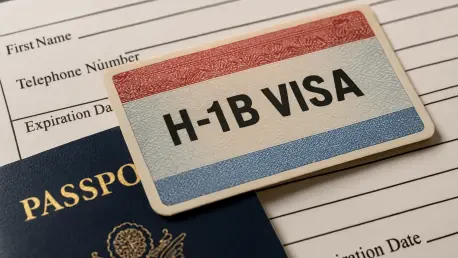Imagine a rural hospital in a remote corner of the United States, already grappling with a shortage of doctors, forced to turn away patients due to a staggering new financial burden imposed by a recently introduced policy. This policy levies a $100,000 fee on each H-1B visa petition, directly impacting the recruitment of international healthcare workers who often fill these critical gaps in care. This roundup article compiles diverse perspectives from medical organizations, policy analysts, and industry stakeholders to explore whether healthcare workers should be exempt from such fees. The goal is to present a balanced view on how this policy affects the healthcare sector, patient care, and broader immigration debates, shedding light on a pressing issue at the intersection of public health and policy reform.
Diverse Perspectives on H-1B Visa Fees in Healthcare
Insights from Medical Organizations on Workforce Shortages
A coalition of over 50 medical groups, representing a wide array of specialties and institutions, has voiced alarm over the new H-1B visa fee structure. These organizations argue that the $100,000 cost per petition creates an insurmountable barrier to recruiting international medical graduates (IMGs), who constitute roughly 25% of practicing physicians in the U.S. Their primary concern centers on the exacerbation of existing shortages, particularly in underserved areas where foreign-trained doctors are often the backbone of care delivery.
The consensus among these groups highlights a stark reality: without IMGs, many communities would lack access to essential medical services. Data shared by these organizations shows that a significant percentage of foreign-trained physicians work in designated shortage zones, addressing needs that domestic talent alone cannot meet. This perspective emphasizes that the fee could cripple an already strained system, pushing hospitals to reduce services or close entirely in vulnerable regions.
Beyond immediate staffing concerns, medical associations stress the long-term implications of this policy. With projections estimating a shortfall of 86,000 doctors by 2036, blocking access to international talent could have catastrophic effects on public health. Their unified stance calls for a targeted exemption, framing healthcare as a unique sector where patient outcomes must take precedence over standard immigration rules.
Policy Analysts Weigh In on Economic Impacts
Policy analysts offer a different angle, focusing on the financial ramifications of the H-1B fee for healthcare institutions. Many note that smaller hospitals, especially those in rural settings, operate on razor-thin budgets and lack the resources to absorb such a hefty cost. This viewpoint suggests that the fee could deter recruitment efforts, leaving critical positions unfilled and further straining local economies that rely on these facilities for jobs and care.
Another layer of analysis examines the potential ripple effects on healthcare disparities. Analysts point out that communities already facing limited access to medical services—often low-income or remote areas—stand to lose the most if hospitals scale back due to financial pressures. This perspective underscores the need for a nuanced policy approach, one that considers the unique economic challenges faced by the healthcare sector compared to other industries utilizing H-1B visas.
Some analysts also explore alternative solutions, such as tiered fee structures based on institutional size or geographic need. They argue that a one-size-fits-all fee fails to account for the diverse capacities of healthcare providers, advocating for flexibility to ensure that patient care remains unaffected. This viewpoint adds a practical dimension to the debate, focusing on how policy design can mitigate unintended consequences.
Hospital Administrators Highlight Operational Challenges
Hospital administrators bring a ground-level perspective, detailing how the visa fee disrupts day-to-day operations. Many express frustration over the sudden financial hurdle, noting that recruiting international talent often requires significant investment even without additional visa costs. For facilities already juggling tight budgets, the fee represents a direct threat to their ability to maintain adequate staffing levels.
A recurring theme from administrators is the impact on strategic planning. With nearly 17,000 H-1B visas granted to medical professionals annually, these workers form a vital part of workforce pipelines. Administrators argue that the fee could force hospitals to abandon long-term recruitment strategies, leading to gaps in specialized care areas like surgery or primary care, where IMGs often play a key role.
Additionally, some administrators raise concerns about community trust. When hospitals fail to deliver timely care due to staffing shortages, public confidence in local healthcare systems erodes. This viewpoint emphasizes that the visa fee issue extends beyond finances, touching on the broader social contract between healthcare providers and the populations they serve, urging policymakers to prioritize access over revenue generation.
Immigration Policy Experts on Balancing Priorities
Experts in immigration policy provide a broader context, examining how the H-1B fee fits into national debates on skilled labor and border control. Many acknowledge the government’s intent to regulate foreign worker programs through financial deterrents, but they question whether healthcare should bear the same burden as other sectors. Their analysis often frames medical professionals as a distinct category, given the direct link between their work and public welfare.
A contrasting opinion within this group suggests that exemptions could set a precedent, potentially weakening the overall structure of visa fee policies. These experts caution against sector-specific carve-outs, arguing that consistent rules ensure fairness across industries. However, they concede that healthcare’s critical nature might warrant special consideration, proposing limited waivers or subsidies as a middle ground to address urgent staffing needs.
Another insight focuses on demographic trends, such as an aging population driving increased demand for medical services. Immigration policy specialists highlight that reliance on IMGs will likely grow in the coming years, making it essential to align visa policies with labor market realities. This perspective pushes for a forward-thinking approach, advocating for reforms that support both immigration goals and the nation’s health infrastructure.
Reflecting on the Roundup and Next Steps
Looking back, this roundup revealed a multifaceted debate surrounding the $100,000 H-1B visa fee and its impact on healthcare workers. Medical organizations underscored the dire risk of worsening physician shortages, policy analysts highlighted economic strains on hospitals, administrators detailed operational setbacks, and immigration experts wrestled with balancing public health against broader policy objectives. Each viewpoint contributed to a richer understanding of a complex issue, showing both consensus on the need for action and divergence on how to achieve it.
Moving forward, stakeholders can consider several actionable paths. Policymakers might explore targeted exemptions or reduced fees for healthcare institutions, particularly those in underserved regions, to safeguard patient care. Additionally, supporting advocacy efforts by medical groups could amplify the call for reform, ensuring that healthcare remains a priority in visa policy discussions. Finally, further research into innovative staffing models or domestic training incentives could complement international recruitment, offering a balanced solution to address long-term workforce challenges.









